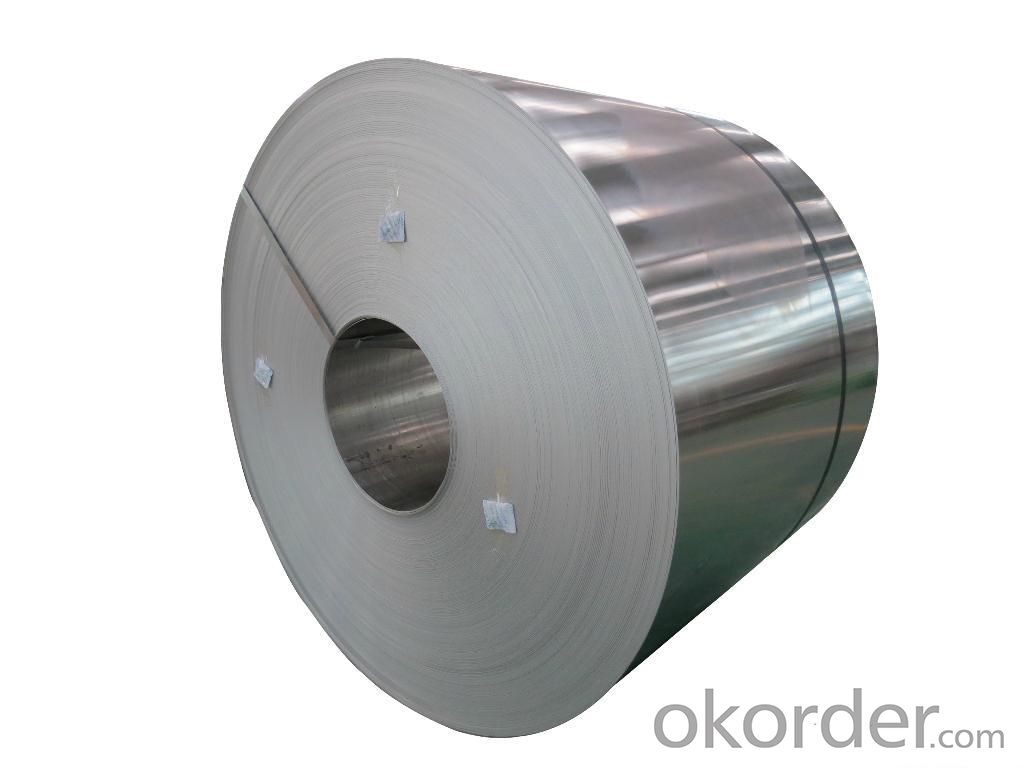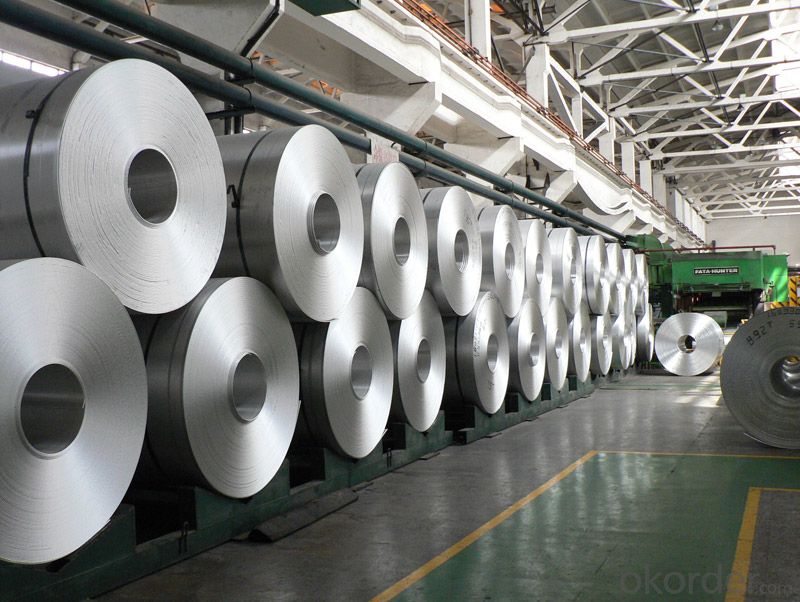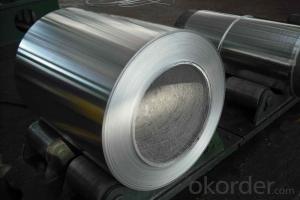Direct Casting Aluminium Coils for Rerolling
- Loading Port:
- Shanghai
- Payment Terms:
- TT OR LC
- Min Order Qty:
- 5 m.t.
- Supply Capability:
- 20000 m.t./month
OKorder Service Pledge
OKorder Financial Service
You Might Also Like
Item specifice
1.Structure of Direct Casting Aluminium Coils for Rerolling
Direct Casting Aluminium Coils for Rerolling is one semi-finished aluminium material. This strip can be rolled down to aluminium coil,sheet,circle ect. The alloy AA1050 is widly used in building, industry ect. Its weight is much lower than steel. So many customers choosed aluminium material instead of steel.
2. Main features of Direct Casting Aluminium Coils for Rerolling
a.Competitive price---We have our own mills and can produce mill finished aluminium coils, so we can control the production cost better.
b.Professional after-sale service---We have more than 15 years exportation experience and you need not worry about the exporation problems.
c.Fast delivery time---We can control the delivery time within 35 days.
3. Image



4. Product Specification
| Alloy | Temper | Thickness | Width | Weight |
| AA1050 | H18,H14,F | 0.2MM-3MM | 1000MM-1500MM | About 2.5 tons |
5.FAQ:
What is the quality standard?
---Usually our standard is GB3880-2006
What is the largest width?
---It is 2300mm
What is the MOQ?
---Usually we can accept 80 tons.
- Q:How thick are aluminum sheets commonly available?
- Depending on the purpose and application, aluminum sheets are typically available in different thicknesses. The most frequently found aluminum sheet thicknesses range from 0.025 inches (0.63 mm) to 0.125 inches (3.18 mm). Nevertheless, there are also thinner and thicker aluminum sheets obtainable, with some being as thin as 0.016 inches (0.4 mm) and others as thick as 0.25 inches (6.35 mm) or possibly more. The specific thickness needed will be contingent upon the particular project or industry application.
- Q:Are aluminum sheets conductive?
- Indeed, aluminum sheets possess conductivity. Being a metal, aluminum exhibits exceptional electrical conductivity. Consequently, aluminum sheets facilitate the smooth passage of electricity, rendering them suitable for an array of applications that necessitate conductivity, including electrical wiring, power transmission lines, and electronic devices.
- Q:What is the surface finish of 101 aluminum sheets?
- The surface finish of 101 aluminum sheets can vary depending on the manufacturing process and desired application. Common surface finishes for 101 aluminum sheets include mill finish, brushed finish, and polished finish.
- Q:How do I cut aluminum sheets?
- To cut aluminum sheets, you can use a variety of tools such as a circular saw, jigsaw, or a metal shear. It is important to choose the appropriate tool based on the thickness and size of the sheet. Additionally, make sure to use proper safety precautions such as wearing gloves and eye protection.
- Q:could magnet attract iron with the seperation of rubber and aluminum sheets?
- It does in theory, but rubber and aluminum sheets can’t be too thick, larger magnetic force of magnet will be better.
- Q:Are aluminum sheets suitable for chemical processing applications?
- Aluminum sheets are a great choice for chemical processing applications. They are widely used in various industries, including chemical processing, due to their versatility. One of the reasons aluminum is preferred is because it has excellent corrosion resistance properties. This makes it ideal for applications that involve exposure to chemicals and corrosive environments. Aluminum sheets can resist many acids and alkalis, including common chemicals like sulfuric acid, hydrochloric acid, and sodium hydroxide. The reason aluminum is so resistant to corrosion is because of the thin oxide layer that forms on its surface. This layer acts as a barrier against chemical attacks and can quickly reform if damaged, providing continuous protection to the metal underneath. Additionally, aluminum is lightweight, has high thermal conductivity, and can be easily shaped and sized, making it a popular choice for chemical processing equipment and components. In chemical processing applications, aluminum sheets are often used for storage tanks, heat exchangers, piping systems, and other equipment that comes into contact with chemicals. They can withstand high temperatures and pressures, making them suitable for various processing conditions. Furthermore, aluminum is non-toxic, non-magnetic, and has excellent electrical conductivity, which can be advantageous in certain chemical processes. However, it's important to consider the specific chemical environment and conditions when choosing aluminum sheets for chemical processing applications. Some aggressive chemicals, like strong bases or highly oxidizing acids, may require additional protection or alternative materials. It's recommended to consult with experts or engineers who are familiar with the specific chemical processes and conditions to ensure that aluminum sheets are suitable for a particular application.
- Q:Are aluminum sheets suitable for automotive heat shields?
- Certainly! Automotive heat shields can indeed utilize aluminum sheets. Aluminum is an exceptional option for heat management in automotive applications due to its lightweight nature and impressive conductivity. Its high melting point and excellent thermal conductivity properties allow it to efficiently absorb and disperse heat produced by the vehicle's engine, exhaust system, and other heat sources. Furthermore, aluminum sheets are easily moldable and can be crafted into diverse sizes and designs, making them adaptable for various automotive heat shield purposes. In summary, aluminum sheets offer an economical and effective means of safeguarding vulnerable components from heat-related harm within automotive systems.
- Q:What are the different methods of surface coloring aluminum sheets?
- Aluminum sheets can be colored using various methods, each with its own strengths and limitations. Let's explore some of the commonly used techniques: 1. Anodizing: Anodizing is a favored method for coloring aluminum sheets. It entails creating a controlled oxide layer on the surface of the aluminum through an electrochemical process. This layer can be dyed in different colors, resulting in a resilient and long-lasting finish. Anodized aluminum is resistant to corrosion, UV rays, and scratches, making it an excellent choice for outdoor applications. 2. Powder coating: Powder coating is another popular technique for coloring aluminum sheets. It involves applying a dry powder coating to the sheet's surface, which is then cured in an oven. The powder melts and forms a protective layer that adheres to the aluminum. Powder coating offers a wide range of colors and finishes, and it provides exceptional durability, fade resistance, and scratch protection. 3. Painting: Painting is a traditional method for coloring aluminum sheets. It requires applying a liquid paint to the surface, which subsequently dries and forms a protective layer. Painting offers a vast array of color options and can achieve various finishes, such as matte, gloss, or metallic. However, painted aluminum sheets may require additional protective coatings to enhance durability and fade resistance. 4. Cladding: Cladding is a technique that involves applying a thin layer of colored material, such as stainless steel, copper, or composite panels, onto the aluminum sheet's surface. This method allows for a wide range of colors and finishes, while also providing extra protection. Cladding can be utilized to achieve a unique aesthetic or enhance the durability of the aluminum sheet. 5. Dye sublimation: Dye sublimation is a specialized method of coloring aluminum sheets, which employs heat and pressure to transfer designs or images onto the surface. This process enables high-resolution prints and vibrant colors, making it particularly suitable for decorative and signage applications. Each method of coloring aluminum sheets has its own advantages and considerations, such as durability, aesthetics, cost, and application requirements. It is crucial to thoroughly assess these factors when determining the most suitable method for a specific project.
- Q:Can 101 aluminum sheets be powder coated?
- Indeed, powder coating is a highly adaptable and long-lasting method of finishing that can be utilized on a multitude of substances, aluminum included. This procedure entails the application of a dry powder onto the surface of the aluminum sheets, subsequently subjecting it to heat and fusion in order to generate a sleek and resilient coating. The extensive assortment of colors and finishes offered by powder coating renders it a perfect option for both enhancing the visual appeal and safeguarding the aluminum sheets.
- Q:How does the thickness tolerance of aluminum sheet affect its usability?
- The usability of aluminum sheet is greatly influenced by its thickness tolerance, which refers to the acceptable deviation from the specified thickness. This tolerance is typically expressed as a range or a plus/minus value. Having a tighter thickness tolerance guarantees that the aluminum sheet consistently meets the desired specifications. This is crucial in industries such as aerospace, automotive, and construction, where precise dimensions are necessary. Even a slight deviation in thickness can have a negative impact on the performance and functionality of the product. For example, in aircraft manufacturing, the thickness tolerance of aluminum sheets used for structural components is of utmost importance. A thin sheet could compromise the structural integrity, while a thicker sheet could add excess weight, affecting fuel efficiency. Similarly, in the automotive industry, precise thickness tolerance is vital to ensure compatibility and fitment of various components. On the other hand, a looser thickness tolerance may be acceptable in applications where precise dimensions are not as critical. For instance, in general fabrication, signage, or decorative purposes, a wider thickness tolerance may not significantly affect the usability or appearance of the aluminum sheet. Furthermore, manufacturing aluminum sheets with tighter thickness tolerances generally incurs higher costs due to increased precision and quality control measures. Therefore, the desired level of tolerance should be carefully balanced with the intended use and cost considerations. To conclude, the usability of aluminum sheet is directly influenced by its thickness tolerance, particularly in industries that require precise dimensions. Selecting the appropriate tolerance level is essential to ensure that the sheet meets the necessary specifications and maintains the desired performance and functionality of the final product.
1. Manufacturer Overview |
|
|---|---|
| Location | |
| Year Established | |
| Annual Output Value | |
| Main Markets | |
| Company Certifications | |
2. Manufacturer Certificates |
|
|---|---|
| a) Certification Name | |
| Range | |
| Reference | |
| Validity Period | |
3. Manufacturer Capability |
|
|---|---|
| a)Trade Capacity | |
| Nearest Port | |
| Export Percentage | |
| No.of Employees in Trade Department | |
| Language Spoken: | |
| b)Factory Information | |
| Factory Size: | |
| No. of Production Lines | |
| Contract Manufacturing | |
| Product Price Range | |
Send your message to us
Direct Casting Aluminium Coils for Rerolling
- Loading Port:
- Shanghai
- Payment Terms:
- TT OR LC
- Min Order Qty:
- 5 m.t.
- Supply Capability:
- 20000 m.t./month
OKorder Service Pledge
OKorder Financial Service
Similar products
New products
Hot products
Related keywords






























